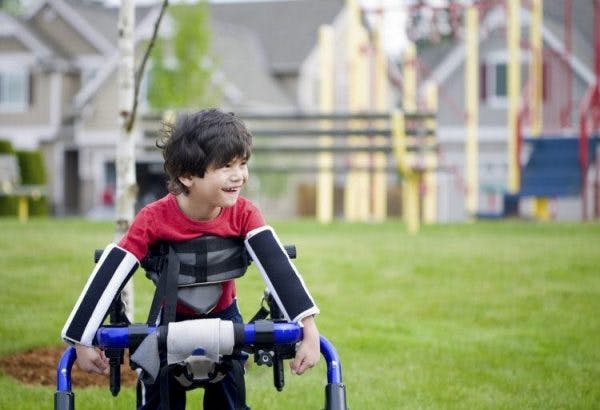Can cerebral palsy progress as you get older? Depending on how you look at it, yes and no. While the brain damage that causes cerebral palsy will not worsen, symptoms like irregular muscle tone can; or with proper management, symptoms can improve over time.
In this article, we’ll cover the progression of cerebral palsy and the best ways to manage it. Use the links below to jump straight to any section.
- Understanding the progression of CP
- Symptoms that may progress
- 9 ways to manage the progression of symptoms
Understanding the Progression of Cerebral Palsy
Cerebral palsy is caused by damage to the brain before, during, or shortly after birth. This brain damage is static and nonprogressive, meaning that it will not get worse or heal itself.
While the physical damage to the brain will not change, the resulting symptoms can get better or worse over time depending on how they’re managed. Addressing symptoms early on can prevent symptoms from progressing and resulting in further complications.
Aside from stopping one’s symptoms from progressing, appropriate symptom management can actually help individuals to improve! One way this is possible is through a process called neuroplasticity. Neuroplasticity allows your brain to rewire functions affected by brain damage to healthy areas of the brain.
The more you practice affected movements, the stronger the neural pathways for those movements will become due to neuroplasticity. This results in more natural feeling (and less effortful) movements. The more you move, the more you stimulate the brain’s ability to adapt.
Cerebral Palsy Symptoms that May Progress
Everyone experiences cerebral palsy differently. While symptoms may vary, the following list includes some of the most common symptoms of cerebral palsy that can progress over time.
Spasticity
One of the most common symptoms of cerebral palsy is spasticity, which occurs when the muscles involuntarily contract and movements become stiff. Around 80% of all individuals with cerebral palsy have spasticity.
Spasticity can range from mild to severe and can affect one or more areas, ranging from affecting just one limb to the entire body. Unmanaged spasticity can progressively restrict one’s mobility, and potentially lead to muscle contractures. Uneven pulling of the muscles and excess pressure on the joints due to spasticity can affect an individual’s posture, growth, and walking patterns.
Musculoskeletal Problems
Other than spasticity, here are a few common musculoskeletal problems individuals with cerebral palsy may experience:
- Scoliosis is a condition that occurs when the spine curves sideways. Although statistics vary, studies suggest between 21% and 64% of people with CP have scoliosis, typically due to poor trunk control and/or spasticity.
- Osteoarthritis occurs when cartilage (the cushioning between your bones at a joint) wears down.
- Osteoporosis occurs when the bones become weak and porous due to lack of use or poor nutrition.
- Hip dislocation can occur due to irregular muscle tone, and is estimated to affect between 15% and 20% of children with CP. Tightness in the muscles and joints can progressively limit one’s mobility, making it easier to accidentally dislocate a joint.
Fatigue
Individuals with cerebral palsy frequently experience fatigue. Because of their motor impairments, individuals with CP tend to use more energy to complete daily activities. For example, individuals with cerebral palsy may require 2-3 times more energy to walk than typically developing peers. Cerebral palsy can also be psychologically draining.
Communication Skills
Cerebral palsy can also affect the facial muscles, making it difficult for people to speak and eat. When communication skills are affected, individuals may need to use alternative forms of communication or repeat themselves several times to be understood.
Some people may decide it is easier not participate in social conversations because it is too frustrating. This can lead to social isolation, resulting in minimal communication with others. When communication skills are not frequently practiced, they are likely to decline.
Pain
Approximately 75% of people with cerebral palsy experience pain. Spasticity, poor postures and abnormal movement patterns may contribute to the development of musculoskeletal pain. If not appropriately addressed, pain can become chronic and may progress in intensity over time.
Mental Health
Although cerebral palsy is a motor disability, it can also indirectly affect an individual’s mental health. Adults with cerebral palsy are more likely to experience mental health disorders, including depression and anxiety, than the general population.
Despite the potential for all of these symptoms to progress, there are many excellent ways to prevent the progression of cerebral palsy.
9 Ways to Prevent the Progression of Cerebral Palsy

As mentioned above, if appropriately addressed, individuals have the ability to slow or prevent the progression of cerebral palsy symptoms. While early management is optimal, individuals of any age can take steps to maximize their functional abilities and quality of life. This is because the brain is always adapting through neuroplasticity to promote improved functions.
Here are nine of the best ways to prevent the progression of cerebral palsy:
1. Physical Therapy
Physical therapy focuses on training proper movement patterns, stretching tight muscles, and strengthening underused muscles. Through physical therapy, individuals can focus on combating spasticity and other musculoskeletal problems in order to manage pain and increase functional skills.
2. Occupational Therapy
During occupational therapy, individuals focus on how to most easily participate in their daily activities. This can include learning strategies to manage spasticity, fatigue, and pain. Engaging in valued activities using strategies learned in occupational therapy can also promote mental health and wellbeing.
3. Speech Therapy
The best way to manage communication difficulties is through speech therapy. During speech therapy, individuals may focus on strengthening their oral motor muscles and articulating their speech more clearly. Those who are non-verbal can learn how to utilize alternative forms of communication like sign language, voice generators, or communication boards.
4. Psychotherapy
Mental health problems, such as depression and anxiety, are often manageable through a combination of psychotherapy and medications. Psychotherapy helps individuals identify ways to effectively cope with mental health symptoms.
5. Orthotics
Braces and other types of orthotics can be used to support proper musculoskeletal alignment and mildly combat spasticity.
6. Medications
Various medications, such as Botox and baclofen, can be used to manage spasticity. Although the effects of Botox and baclofen can wear off, participating in therapy while under their effects can result in long-lasting improvements due to neuroplasticity. Medications can also help manage mental health symptoms and pain.
7. Heathy Habits
Regular physical activity and proper nutrition can keep cerebral palsy symptoms from progressing. Engaging in physical activities, even for just a few minutes per day, is a great way to address fatigue and mental health problems.
Daily physical exercise can also help to manage spasticity and alleviate pain. Proper nutrition is essential to promote development and growth. It can also help keep the muscles and bones strong to deter the onset and progression of musculoskeletal problems.
8. Surgery
For those with severe spasticity, surgery may be recommended to prevent the progression of cerebral palsy. Surgery may involve manually lengthening tight muscles and/or denervating hyperactive nerve roots.
9. Support Groups
Joining a cerebral palsy support group is a great way to meet others with similar challenges and learn new ways to manage cerebral palsy symptoms. A support group can also help individuals gain motivation to manage their cerebral palsy symptoms and improve their quality of life.
Using these strategies, individuals may slow or prevent the progression of cerebral palsy symptoms. Furthermore, they may even be able to improve their symptoms for a better overall quality of life.
Progression of Cerebral Palsy: Key Points
The brain damage that caused cerebral palsy will not progress, but symptoms of CP can worsen and interfere with your day-to-day life. Cerebral palsy is a lifelong condition, so it’s essential to stay on top of managing its symptoms.
Hopefully, this article helped you understand why CP can appear to worsen over time and how to prevent symptoms from progressing.










